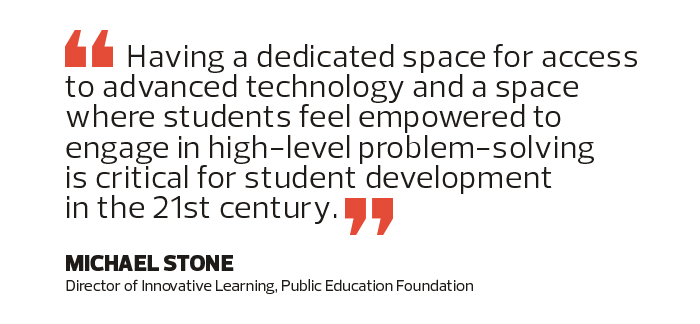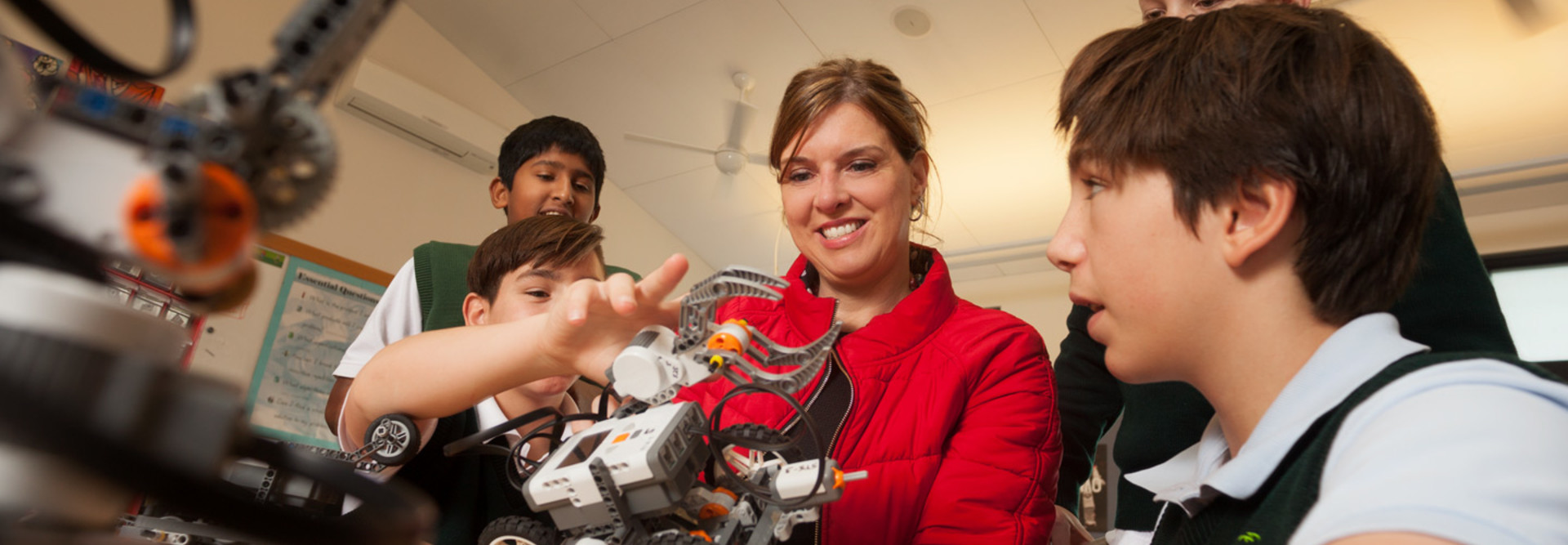STEM Labs Inspire Students, Power Innovation in K-12 Schools
St. Thomas School near Seattle hopes to encourage students to develop a passion for science, technology, engineering and math (STEM) by starting them young and engaging them with cool, new learning spaces featuring robots and 3D virtual reality computers.
The independent private school in Medina, Wash., starts using technology in prekindergarten and weaves technology into every subject from fourth to eighth grade. The school’s computer science curriculum, for example, starts in preschool with simple wooden robots, allowing students to learn the fundamentals of coding and become confident creating with technology at an early age.
Even though the school equips every student with a Microsoft Surface tablet, it has built two dedicated spaces to bolster STEM education: a computer lab for robotics and coding; and a zSpace lab full of 3D virtual reality computers that allow students to study human anatomy, dive into a volcano and explore the solar system.
“Studies show that the earlier you introduce STEM education, the more children become interested in those subjects,” says Kimberly Mecham, director of St. Thomas School’s Center for Leadership and Innovation. “We are seeing more of an interest from our students in creating, building and being curious about things. A lot of kids are engaged, including girls, and that’s our goal.”
Schools and districts are investing in STEM education to provide students the skills they need to thrive in their future careers, from technical skills to critical thinking, problem-solving, creativity, communication and collaboration.
Many schools are building dedicated high-tech learning spaces to start or invigorate their STEM programs. Advanced manufacturing labs, for example, provide hands-on learning experiences where students can design products on computers and build those products with 3D printers, laser cutters and other computer-connected equipment.
“Having a dedicated space for access to advanced technology and a space where students feel empowered to engage in high-level problem-solving is critical for student development in the 21st century,” says Michael Stone, director of innovative learning for the Public Education Foundation, a nonprofit that aims to transform public education in Tennessee and has helped build digital fabrication labs in schools with the assistance of corporate and state grants.
“It’s creating a student-centered, student-driven space,” Stone adds. “Silicon Valley corporations have moved away from cubicles to creating collision spaces where ideas can come to life. If that works at companies like Google and Apple, the same mindset should be in schools.”
Critical Thinking Spaces Spark Opportunities for All
Through STEM education, schools are teaching the design thinking concept of understanding a problem, creating a solution, testing and iterating on it, and once perfected, sharing it with the world. While the ultimate goal is to attract students into STEM careers because the U.S. has a shortage of skilled workers in fields such as engineering and computer science, the skills students learn from STEM are applicable to everything they do, educators say.
“It’s about being able to critically think and have them productively struggle and fail, learn from that and work through the problems. It’s really an authentic way of learning,” says Susan Ramsey, science coordinator at Charlottesville City Schools in Virginia.
In an effort to inspire its 4,300 students, particularly underrepresented groups such as girls and people of color, to explore STEM, the district has created a welcoming and creative environment for every student who wants to take part.
“Our students don’t have to fill out applications to join the programs. We don’t look for the ‘best and the brightest.’ We are looking for anyone with an interest,” says Ramsey, who in recent years has beefed up the district’s STEM program to include all grades. “We tell students, ‘If you want to be in engineering, you can be in engineering.’ ”
That commitment includes building state-of-the-art labs at its middle and high schools, where students can work on projects as part of their engineering courses or after-school clubs.
The 7,200-square-foot Sigma Lab at Charlottesville High School is a flexible learning space that includes a computer lab and an advanced fabrication lab with network-connected 3D printers, CNC machines and laser cutters, where students can design and build products such as prosthetic limbs and quadcopters. The space also includes informal collaborative spaces with soft armchairs and glass-walled project rooms with tables, whiteboards and interactive displays, so students can work on projects together.
Tech Infrastructure and Support Allows for Classroom Innovation
The district equips students in grades three through 12 with Chromebooks, but to access software necessary for STEM activities, such as computer-aided design programs and Adobe Creative Cloud, the IT department needed high-powered Windows-based computers, says Jeff Faust, the district’s technology director. Charlottesville standardized on Lenovo ThinkCentre All-In-One desktop computers in its middle and high school tech labs.
At the Sigma Lab, the computers link to a video wall of 12 large, interconnected NEC LED displays, which allow teachers to show video clips, snippets of software code or students’ computer screens.

Schools need a robust network to support a high-tech STEM lab, Faust says. The district built a dedicated 1-gigabit-per-second LAN for the Sigma Lab, which is backhauled to the 10Gbps network core at district headquarters. The IT staff also placed the computer and video wall’s network traffic in its own virtual LAN to ensure the equipment had ample bandwidth.
“We wanted to protect video traffic and make sure it’s as high quality as possible,” he says.
The IT department has installed Cisco Meraki wireless access points throughout the district, including inside the lab. With Wi-Fi, students can also use their Chromebooks to work and collaborate in the project rooms, Faust says. In fact, the IT staff created a special service set identifier on one of its APs so students can connect lab computers wirelessly to robotic devices.
Robots and Virtual Reality Provide Hands-On Experience
At St. Thomas School, Mecham says that even though students are issued Microsoft Surface devices, it’s important to provide them with a dedicated computer lab for two reasons: High-powered desktop computers give students the performance they need for video editing and other specialized software, and large touch-screen monitors provide students more real estate on which to do work.
First- to eighth-grade students use the lab’s 19 Dell desktops not only for video production, but also for robotics and coding. “It makes it easier for them to split their screen to code and read directions or research things on the internet,” she says.
The room is made to be flexible. The computers are on the sides with tables in the middle where students can work on their robots. Sometimes they push the tables into different configurations (or push them out of the room altogether) so they can work on the floor and create obstacle courses for their robots, Mecham says.
Preschoolers use wooden robots that are programmable with blocks that have simple commands, such as forward, stop or turn left. Older students work with more sophisticated robots. Humanoid robots, for example, are programmable using drag-and-drop commands or with Python or another programming language.
The robots are easy to support. While students can connect some robots to the wireless network, they can also send instructions to their robots by connecting wirelessly on their tablets through Bluetooth, Mecham says.
The virtual reality lab, designed for third to eighth graders, features 12 3D VR computers and several 3D printers on carts. Students, working in pairs, wear 3D glasses and use a stylus to pick things up and see objects from every angle. They can take virtual fieldtrips to museums and design objects that they then print on the 3D printers, she says.
Discovery Center Lets Educators and Students Explore
In Potomac, Md., the Bullis School opened its dream STEM building last September. The independent K–12 school with 800 students nearly doubled its classroom space with the opening of its $25 million Discovery Center, a 70,000-square-foot state-of-the-art building with more than 20 classrooms and science labs, a makerspace, a fabrication lab, a digital media studio and telepresence hall.
The facility allows Bullis School to expand its STEM course offerings, says Faith Darling, the school’s STEM director.
“We were bursting at the seams, and this creates flexible learning spaces that allow for more sophisticated learning experiences,” she says.
Each room uses Crestron control panels to control lights and projectors. One computer lab features 3D VR computers. The digital media classroom includes eight high-end Dell laptops with Adobe Creative Suite for students to edit video, as well as a sound studio and a wall painted green to serve as a green screen. The makerspace areas include robotics and 3D printers, says Jamie Dickie, Bullis School’s technology director.
The Discovery Center, which has a wireless network built with Aruba equipment, includes some unique classroom spaces. For example, the X Classroom is a math classroom that has four tables configured in an X, so there is no front or back to the room. This setup encourages collaboration and project-based learning. At the end of each table are video screens, allowing students to plug in their computers and display their work.
“You can share with a large group or focus on smaller group work,” Dickie says. “People don’t associate math with project-based learning, but we want that to be our approach.”
Designing and building the Discovery Center required school leaders to explore what kinds of technologies were available and how teachers might actually use them. An important philosophy, Darling says, is that technology should support the program — don’t just purchase technology for technology’s sake.
“It’s making sure that technology is not the thing that takes over. The priority is the pedagogy and ensuring that we have the technology to support what we are trying to accomplish,” she says.
Overall, creating dedicated STEM spaces in schools is important to a sizable and growing portion of a district’s student body, says Charlottesville’s Faust. “It goes back to what a student said to us: ‘If you are an athlete, you join a sports team. If you are a performing arts student, you have theater, visual arts or music. But where is the place for geeks?’ ” he recalls. “The STEM lab is an avenue to reach students who want to express themselves creatively but not through athletics or music.”









